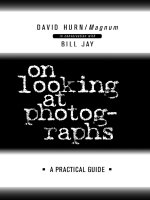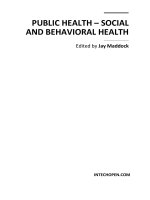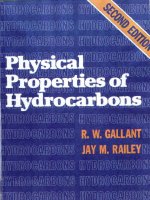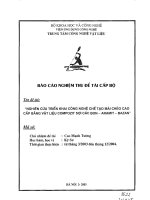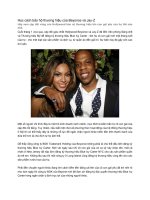jay aram
Bạn đang xem bản rút gọn của tài liệu. Xem và tải ngay bản đầy đủ của tài liệu tại đây (1.15 MB, 8 trang )
Department of
Veterans Affairs
Journal of Rehabilitation
Research and
Development Vol
. 32 No
. 2, May 1995
Pages 162-169
Experiments in dysarthric speech recognition using artificial
neural networks
Gowtham Jayaram, MS and Kadry Abdelha led, PhD
Department of Biomedical Engineering, Louisiana Tech University, Ruston, LA 71272
Abstract—In this study, we investigated the use of artificial
neural networks (ANNs) to recognize dysarthric speech
. Two
multilayer neural networks were developed, trained, and tested
using isolated words spoken by a dysarthric speaker
. One net-
work had the fast Fourier transform (FF1') coefficients as inputs,
while the other network had the formant frequencies as inputs.
The effect of additional features in the input vector on the recog-
nition rate was also observed
. The recognition rate was evalu-
ated against the intelligibility rating obtained by five human
listeners and also against the recognition rate of the Introvoice
commercial speech-recognition system
. Preliminary results
demonstrated the ability of the developed networks to success-
fully recognize dysarthric speech despite its large variability.
These networks clearly outperformed both the human listeners
and the Introvoice commercial system.
Key words
:
artificial neural networks, cerebral palsy,
dysarthric speech, speech recognition.
INTRODUCTION
While users need not have "normal or perfect" speech
to exploit available speech recognition systems, the input
speech must be consistent. This usually seems impossible
for individuals with cerebral palsy because of their lack of
Address all correspondence and requests for reprints to
: Kadry Abdelhamied,
PhD, Center for Assistive Technology, State University of New York at Buffalo,
Buffalo, NY 14214
.
control of articulatory movements daring speech produc-
tion. The inconsistency in dysarthric speech precludes its
recognition by currently available commercial systems (1).
Miller et al
. (2) analyzed the speech variations in utter-
ances produced by individuals with cerebral palsy in a
speech recognition study using the Dragon VoiceScripe
system
. They reported that the accuracy of the system was
extremely dependent on the repeatability of voice com-
mands in the tone and spectral content
. In another study,
using the Interstate Voice Products' speech recognition
system with a dysarthric speaker afflicted with cerebral
palsy, Lee et al
. (3) reported that, even with retraining, the
subject only reached an overall accuracy of 70 percent.
Carlson and Bernstein (4) reported a wide range of per-
centage of recognition from speaker to speaker in a study
involving 50 subjects with articulation disabilities, mainly
with hearing impairment and cerebral palsy
. The system
was more successful for the subjects with hearing impair-
ment than for the subjects with cerebral palsy.
Goodenough and Rosen (5) reported that speech
recognition performance rapidly deteriorated for vocab-
ulary sizes greater than 30 words, even for persons with
mild to moderate dysarthria
. It is likely that individuals
whose dysarthria is severe enough to derive benefits from
using augmentative communication devices may not be
expected to gain much from these commercially avail-
able speech recognition systems
. There are also various
disadvantages to these commercial systems
; such as, the
requirement for repeatable word patterns between train-
ing and operation, the inability to cope with ambient
162
163
JAYARAM and ABDELHAMIED
: Dysarthric Speech Recognition
noise, and inadequate interfaces with rehabilitation
devices (2).
Recent research has focused on the assessment of
dysarthric speech and the utility of computer-based speech
recognition systems
. Sy and Horowitz (6) described a
causal model which addressed important issues
; such as,
using normal speech as a control in evaluating dysarthric
speech, categorizing speech errors in terms of its features,
and determining the relationship between intelligibility
rating and speech recognition performance. Coleman and
Meyers (7) examined computer recognition of dysarthric
speech through the use of a structured model and con-
cluded that the low overall recognition rate of dysarthric
speakers remains a serious problem. These researchers
suggested that this problem could be approached in two
ways
: changing the speech input signal and changing the
recognition system.
Changing the speech input signal possibly might be
achieved through speech training and therapy, but this is
unlikely
. Changing the recognition system, on the other
hand, involves the development of more robust techniques
to handle the variability and inconsistency in dysarthric
speech
. Possibilities include the development of algo-
rithms that filter out sounds beyond a certain length and at
certain frequencies
. Another possible technique is the use
of artificial intelligence through which the algorithm can
learn and compensate for the types of inconsistencies pro-
duced by the speaker (7)
. A third technique is based on the
modeling of useful parts of cerebral palsy speech
; such as,
vowel-like strings punctuated by inappropriate (compared
to normal speech patterns), sounds and silences
. Using this
technique, known as hidden Markov model (HMM), an
overall recognition rate of 90 percent was reported for
vowel sounds (8)
. Similar results were also obtained by
Boonzaier and Limon (9).
The use of HMMs, despite their relative success, has
many limitations
. These include poor low-level acoustic
modeling and poor high-level semantic modeling
. Poor
low-level acoustic modeling leads to confusions between
acoustically similar words, while poor high-level seman-
tic modeling restricts applications to simple situations with
limited vocabulary
. Also, HMMs do not model coarticu-
lation directly and cannot model the topological structures
of words and subwords (10)
. These limitations are more
pronounced for cerebral palsy speech because of its high
degree of variability
. In addition, HMM theory does not
specify the structure of implementation hardware which is
important for interfacing with rehabilitation devices
.
The use of artificial neural networks in speech recog-
nition provides the potential to overcome these limitations.
Neural networks can perform better than existing algo-
rithms because they adapt their internal parameters over
time to maximize performance and self-organize to cap-
ture new features as they are observed (11). During train-
ing, the neural networks successively update information
learned from past experiences, giving them the ability to
handle variations and inconsistencies in the speech signal
and to process incomplete or missing data (12)
. Lerner and
Deller (13) pointed out that neural network structures may
hold promise for recognition of cerebral palsy speech.
They introduced a neural network approach to learning in-
variant spectral features in cerebral-palsied speech.
This approach was adopted in the present study
. First,
an attempt was made to identify the range of variability in
dysarthric speech (a complete account of dysarthric speech
can be found in references 14 and 15). Since cerebral palsy
is
the most common cause of dysarthria, a subject with
cerebral palsy was selected for this purpose
. It should be
emphasized that many of the features of cerebral palsy
speech (e
.g
., variability) are also features of dysarthria re-
sulting from traumatic brain injury, stroke, or multiple scle-
rosis
. Our subject's dysarthric errors, therefore, may also
be found in the dysarthric speech of others with neuro-
genic communicative disorders
. Second, we investigated
the development of a high-performance recognition sys-
tem for dysarthric speech using the technology of artifi-
cial neural networks.
METHODS AND MATERIALS
Subject
JIB,
aged 33,
has cerebral palsy
. His physical condi-
tions include quadriplegia, spasticity, and athetosis
. He has
a bachelor's degree in sociology
. He has used a direct se-
lection device for 2 years (Light Talker made by Prentke-
Romich Co
., Wooster, OH)
. This device has a light-pen
selector attached to a head band and a speech synthesizer
to produce the selected message
. Using this device, he can
communicate an average of five words/minute
. He is as-
sisted in writing by a scribe who is familiar with his speech.
As a child, he received speech therapy for about 10 years.
His intelligibility score is 10–20 percent for average lis-
teners and about 60 percent for people who are familiar
with him
. When asked to produce 25 multisyllable corn-
164
Journal of Rehabilitation Research and Development Vol . 32 No
. 2 1995
mands such as "RETURN," "CLEAR," "RIGHT," and
"DIRECTORY," a recognition rate of 20 percent was ob-
tained using the IntroVoice speech recognition system
. He
uses a joystick to control his electric wheelchair
. On sev-
eral occasions, we met with JK to discuss the proposed
system
. He thought that it would be better for him to have
a speech-recognition system
. He said it would be faster
than his device
. "I like to talk," he added.
Speech Materials
The vocabulary for this study was selected using the
following criteria
: 1) use of monosyllabic words to
initially simplify analysis
; 2) inclusion of all vowel
phonemes
; 3) number of required words minimized (for
the subject's convenience and to limit the amount of data
to be analyzed) ; 4) words have a real-world application for
the client such as augmentative communication or envi-
ronmental/wheelchair controls
; and 5) words are easily
recognizable by the subject and have only one normal
pronunciation
. From a list of 50 words, the client made a
short list of 20 words with which he was comfortable
. Each
word in the vocabulary was repeated 22 times
.
Table 1
gives the list of the words used in this study.
Speech Processing
The recorded speech was amplified using Realistic
SA-150 equipment
. The output of the amplifier was then
fed to an adjustable analog filter, a Krohn-Hite Model
3850
. This acted as the anti-aliasing filter and was set to
low-pass at 5 kHz . The output of the filter was next passed
Table
1.
List of the words used
.
No
.
Word
No
.
Word
1
ONE
11
GO
2
OFF
12
START
3
HOW
13
FIVE
4
I
14
HAVE
5
WHY
15
WHAT
6
NO
16
HOME
7
PAIN
17
SIX
8
STOP
18
TURN
9
SAD
19
WHO
10
FOUR
20
ON
to the Data Translation DT2821 analog-to-digital con-
verter
. The sampling rate was set at 10 kHz.
A DOS batch file using ILS (16) software was used
to effect segmentation of the words (i
.e
., finding the
beginning and ending of a word)
. Each utterance was nor-
malized to 45 frames at 256 points per frame
. The seg-
mented data were stored on an 80386, 40 MHz computer
under appropriate names to distinguish the utterance and
the repetition number, token, of that particular utterance.
Feature Extraction
The fast Fourier transform (FFT) coefficients and the
formant frequencies were extracted from all segmented
data
. The FFT were obtained by applying an eighth order
(256 point) FFT to each frame of the segmented data
. Only
the real magnitudes of the FFT were used
. Each frame pro-
vided 128 data points which were reduced to 16 points
using the Turning-Point algorithm (17)
. The frequency,
amplitude, and the bandwidth of the formants were ex-
tracted using linear predictive coding (LPC) analysis (18).
The Interactive Laboratory System (ILS) was used to seg-
ment the speech signal and compute the linear predictive
coefficients
. These coefficients were next extracted using
a program written in C language and then stored in sepa-
rate files
. The energy level of each frame was also pro-
vided by this program
. The energy level was used to test
the effect of additional features on the recognition rate.
Network Design
Two multilayer neural networks (19) were developed,
trained, and tested using NeuralWare's Professional II/Plus
package (20)
. One network had the FFT coefficients as in-
puts, while the other network had the formant frequencies
as inputs . Both networks had hetero-associative, feed-for-
ward, fully connected network configurations using a
back-propagation learning algorithm and sigmoid transfer
function
. The main parameters of the network, number of
layers, learning coefficients, and momentum were main-
tained the same so as to facilitate comparison of the recog-
nition rate obtained by the two networks.
FFT Network
This network consisted of four layers
: an input layer,
an output layer, and two hidden layers
. The input layer had
720 processing elements (PE)
. These PEs correspond to
the 720 elements (16 elements/frame, 45 frames) in the
input vector, representing each utterance
. The first hidden
layer had 270 PEs and the second had 90 PEs
. The num-
ber of PEs in the output layer was determined by the num-
165
JAYARAM and ABDELHAMIED
: Dysarthric Speech Recognition
ber of words in the vocabulary (i
.e
., 20)
.
Figure 1
gives a
schematic diagram of the neural network used in this study.
Formant Network
All the parameters in the FFT network were main-
tained except for the number of PEs, which was determined
by the number of elements in the input vector
. For the for-
mant network, the input layer had 645 PEs, hidden layer
1 had 258 PEs, hidden layer 2 had 86 PEs, and the output
layer had 20 PEs.
Network Training
The network was trained using the method of super-
vised learning
. The data were presented to the network
which produced an output
. The difference between the ac-
tual output and the desired output was calculated and fed
back to change the connections between the processing el-
ements
. From a total of 22 tokens per word in the vocab-
ulary, a training set and a testing set were created
. The
training set consisted of 18 tokens/word, and the testing
set consisted of 4 tokens/word
. The separation of the to-
kens into training and testing sets was done randomly
. The
training set was further broken down to produce subsets
with 6, 9, 12, 15, and 18 tokens.
Network Testing
The accuracy of the speech recognition network is
defined by the
recognition rate,
which is the percentage
ratio of recognized tokens to the total number of tokens
Figure 1.
Schematic of the neural network
.
used in testing the performance of the network
. To find
the optimum number of training iterations, the network
was saved every 1,500 iterations for the first 20 check
points, and from then on saved at every 10,000 iterations
up to 100,000 iterations
. The effect of increasing the num-
ber of training tokens on the recognition rate was also
studied.
System Evaluation
The performance of our system was evaluated by
comparing its recognition rate to the recognition rate ob-
tained by the Introvoice speech recognition system
. The
recognition rates were also compared with the intelligi-
bility ratings obtained on the subject's speech by five lis-
teners with normal hearing. The intelligibility rating was
obtained by using the Modified Rhyme Test (21,22) which
is an ANSI standard (23) for testing intelligibility
. This was
a completion type, wherein the five listeners were provided
with the stem of a word and then asked to fill in the first
letter of the word they heard. Each error made in recogni-
tion of the initial consonant provided a clue to what kind
of error the speaker made (i
.e
., a placement error, voicing
error, and so forth)
. The order of the listening task and the
replay of the speech recordings were randomized
. Each
listener was asked to select one word from a set of six
rhyming words. The percentage of words correctly iden-
tified by each listener determined the intelligibility score.
The average intelligibility score for the five listeners was
then calculated for the speaker.
RESULTS
FFT Network
Figure
2 shows the variation of recognition rate with
an increase in the number of iterations
. This was for a net-
work trained with 18 tokens
. The 100 percent recognition
rate was obtained when the network was tested using the
training set
. For the standard testing set (different sets were
used for training and testing), the recognition rate im-
proved as the number of iterations increased
. A peak recog-
nition rate of 76
.25 percent was reached at 13,500
iterations, after which the rate dipped slightly to 75
.25 per-
cent and saturated thereafter.
Figure 3
shows the variation of the recognition rate
as the number of training tokens increased
. A gradual im-
provement was observed with the increase in the number
166
Journal of Rehabilitation Research and Development Vol
. 32 No
. 2 1995
Figure
2.
Recognition results for FFT network.
Figure
3.
Effect of training for FFT network.
of training tokens
. A peak recognition rate of
76
.25
per-
cent was obtained for 15 training tokens and 18 training
tokens
. The activation levels of the two networks were
studied to select the better network
. In this experiment, the
activation level was calculated as the difference between
the highest activated node and the value of the second high-
est activated node in the output layer
. This gave a measure
of confidence with which a particular word was recog-
nized
. The network trained with 18 tokens had more rec-
ognized words falling in the higher confidence region than
the network trained with 15 tokens
. Hence, 18 was selected
as the optimum number of training tokens in this experi-
ment
. The number of training tokens becomes more criti-
cal in dysarthric speech, considering the limited ability of
the client to produce utterances without fatigue affecting
his speech production
.
The confusion matrix of the network trained with 18
training tokens is shown in
Table
2
. It shows that only the
words `go' and `turn' (i
.e
., words 11 and 12) had low recog-
nition rates
. This demonstrated the inability of the subject
to articulate these two words
. The subject indicated that
he was not comfortable producing these two words
. This
led us to further investigate his speech patterns before final
development of the system.
The energy level of the speech signal was next added
to the input vector to study the effects of additional features
on recognition rate
. The training set with 18 training tokens
was used and a peak recognition rate of 78
.25 percent was
obtained
. This represented an improvement of 2
.25 percent
over the peak recognition rate obtained before.
Formant Network
Figure 4
shows the recognition rate of the formant
network trained with 18 tokens
. This figure shows that a
peak recognition rate of 42
.5 percent was obtained
. This
indicated that the formant frequencies were not able to ac-
curately track the variations in dysarthric speech as did the
FFT network.
Figure 5
gives the peak recognition rate as a func-
tion of the number of training tokens
. A gradual improve-
ment was observed with an increase in the number of
training tokens
. A peak recognition rate of 42
.50 percent
was obtained for the network trained with 18 tokens.
Evaluation Results
The Introvoice was trained with the same set of 20
words, and the number of training tokens was varied from
6 to 18
. A peak recognition rate of 37
.5 percent was ob-
tained when the system was trained with 15 tokens
. The
recognition rate did not show a steady improvement as a
function of number of tokens.
An average intelligibility of 42
.38 percent was scored
for the subject's speech by the five listeners
. The results
of the Rhyme test are summarized in
Table 3
.
Most of the
errors were associated with the phonemes that required ex-
treme articulatory positions (i
.e
., stops like Itl,
/di,
/pi and
fricatives)
. Again, studying these patterns is the focus of
our current research.
CONCLUSION
This study presented a neural network approach to
recognizing isolated words spoken by a dysarthric speaker.
The network ability to recognize the target words was corn-
100
60-
A
a)
cc 40
_OOCOOCCOOOOCCOOOCOOOCCOOOOC
AA
e
training
set
A
testing set
o intelligibility
20
-A
0
.
~
0
13
.5
27
100
Number of Iterations (thousands)
100
80-
A A A
A
40_
0 0 0 0 0 0 0
cc
A
20-
0
0 3 6 9 12151321
Number of Training Tokens
A
testing set
0
Intelligibility
167
JAYARAM and ABDELHAMIED
: Dysarthric Speech Recognition
Table 2.
Confusion matrix for
FFT network trained with 18 tokens.
1iuuin•iuuiu
EMi~
MME
IMMMIMINEMIMMIMMEMIOUINIMIMIEMMEI
s®
n
©
nnn
IIM
nn
.
nnnn
©
n
MIMII
ZIuMuuu©uuuuuu•M•M
.M
EMMMIMIMMMIIMNIMIMMMMNIOM•l
io
100
100
30-
60-
a)
40-
0 0 0 0
9
0
v
T
testing set
0
Intelligibility
20°
0
0 3
6
9
12 15 18
21
Number of Training Tokens
60 -
® training set
V
testing set
0
intelligibility
20
0
0
13
.5
27
100
Number ofIterations
(thousands)
y®
Figure 4.
Recognition results for formant network
.
Figure 5.
Effect of training for formant network.
pared with that of the Introvoice speech recognition sys-
tem and the intelligibility rating for a speaker determined
by experienced human listeners
. The results show the abil-
ity of the developed networks to successfully recognize
dysarthric speech despite its large variability
. These net-
works clearly outperformed both the human listeners and
the Introvoice commercial system
. These results are sum-
marized in Figure 6
.
The results also demonstrated that an increase in
recognition rate was observed with addition of the energy
level to the input feature vector
. Adding more features such
as zero-crossing rate to the input vector will possibly fur-
ther improve the recognition performance
. Currently, we
are looking into those features that are most related to the
intelligibility of dysarthric speech. More research is also
needed to establish the validity of the approach under
168
Journal of Rehabilitation Research and Development Vol
. 32 No
. 2 1995
Table 3.
Confusion matrix for Rhyme
Test.
NOMMIMIIMWMMWIIKKIIMIMINIMK
zo
nnn
MI
nn
®
nn
M
nnnnn
.
•®U®
nnnnn
20
©MI
n nnn
.:
©
.~®
n
MM
n
.
.
©~
n
~
nnn
w;
©©®
n
u©©
.
n
©u
nnnnn
N=l
IMMMMMIMIMMMIMMMIMMIINMMMMB
muuuu©©®0MIIMM0uMMuIM
0•uuu®MI®NIu®uuuu•uua
'
.mu©
nn
©©
n
30
nn
©
nnnnn
.•©MMIMI ° 11©©©~~M
©
i
©
.®u
oa
•©uMu®uiuM u iiuu
vmfM0u0®amuuumu
~,
MMMMMO
•©m
n
u© ovvvv©mv©u
n
u
EMEMIMIMEMIlE
vuuuuuu•uuu
uuuuuuuMB
®uuuuuuuIuuuuuuuuuN
mimm
Figure
6.
Summary of recognition results
.
disorder and poses the challenge to speech recognition
technology
. Although the study focuses on one diagno-
sis, many of the features of cerebral palsy speech (e
.g
.,
variability) are also features of dysarthria that is the re-
sult of traumatic brain injury, stroke, or multiple sclero-
sis
. The data presented here, therefore, have implications
for dysarthric individuals other than those with cerebral
palsy
.
We believe that the approach described in this study
is an important step toward automatic recognition of
dysarthric speech. This will eventually lead to the devel-
opment of effective voice-input communication and con-
trol assistive devices for individuals with cerebral palsy
and others with neurogenic communication disorders.
100
80-
A A A
A
A
0
o
0
A
FFT
0
Intelligibility
v
Formants
q
Introvoice
20-
0
0 3 6 9
12 15 18 21
Number
of Training Tokens
60-
40
_ 0 0 0
greater phonemic environment, expanded vocabulary, and
with a group of speakers.
We would like to emphasize that the use of a single
case with dysarthria as a result of cerebral palsy is ap-
propriate for this study
. Cerebral palsy is the most com-
mon cause of dysarthria
. Variability is the hallmark of this
ACKNOWLEDGMENTS
The authors would like to thank the staff and em-
ployees of the Center for Rehabilitation Sciences and
Biomedical Engineering at Louisiana Tech University for
their assistance
. Special thanks to Dr
. Frank Puckett, Ann
Harvard, and James Kropp
.
169
JAVARAM and ABDELHAMIED
:
Dysarthric Speech Recognition
REFERENCES
11
.
Hecht-Nielsen R
. Neurocomputing
. New York
: Addison-Wesley
12
.
Publishing Co
., 1990.
Bottou L, Soulie FF
. Speaker-independent isolated digit recogni-
1
.
Elliot D
. A computerized speech recognizer for dysarthric speech.
In
: Proceedings of the 40th Annual Conference on Engineering in
Medicine and Biology, Niagara Falls, NY, 1987
:9
:63
.
tion
: multilayer perceptrons vs
. dynamic time warping
. Neural
Networks 1990
:3
:453-65.
2
.
Miller GE, Etter BD, Bartholomew JC
. Analysis of voice pro-
13
.
Lerner S, Deller J
. Neural network learning of spectral features of
cessing for the control of devices to aid the disabled
. In:
Proceedings of the 12th Annual RESNA Conference, 1989, New
Orleans, LA
. Washington, DC
: RESNA Press, 1989
:410-2
.
non-verbal speech
. In
: Proceedings of the IEEE International
Conference on Acoustics, Speech, and Signal Processing, New
York, NY, 1988
:24
:43-6.
3
.
Lee WC, Blackstone SW, Pook GK
. Dysarthric speech input to
14
.
Mysak ED
. Cerebral Palsy
. In
: Shanes GH, Wiig EH, eds
. Human
expert systems
: electronic mail and daily job activities
. In:
Proceedings of the American Voice Input/Output Society, 1987,
communication disorders . Columbus, OH
: Merill Publishing Co
.,
1986
: 513-60.
San Jose, CA
: AVIOS 1987
:33-43
.
15
.
Lehiste I
. Some acoustic characteristics of dysarthric speech.
4
.
Carlson GS, Bernstein G
. Speech recognition of impaired speech
.
Basil, Switzerland
: S
. Karger, 1965.
16
.
ILS [Interactive Laboratory System] reference manuals, STI
5
.
In
: Proceedings of the 10th Annual RESNA Conference, 1987, San
Jose, CA
. Washington, DC
: RESNA Press, 1987
:103-5.
Goodenough C, Rosen M
. Towards a method for computer inter-
17
.
International, Santa Barbara, CA
: STI Neural Networks, 1990.
Tompkins WJ, Webster JG
. Design of microcomputer based med-
face design using speech recognition
. In
: Proceedings of the 14th
Annual
RESNA
Conference,
1991,
Kansas
City,
MO
.
ical instrumentation
. Englewood Cliffs, NJ: Prentice Hall, Inc
.,
1981.
Washington, DC
: RESNA Press 1991
:328-9
.
18
.
O'Shaughnessy D . Speech communication
: human and machine.
6
.
Sy BK, Horowitz DM
. A statistical causal model for assessment
New York
: Addison-Wesley, 1986.
of dysarthric speech and the utility of computer based speech
19
.
Kammerer B, Kupper W
. Experiments for isolated-word recogni-
7
.
recognition
. IEEE Trans Biomed Eng 1993 :40(12)
:1282-98.
Coleman CL, Meyers LS
. Computer recognition of the speech of
tion using single and two-layer perceptrons
. Neural Networks
1990
:3
:693-706.
adults with cerebral palsy and dysarthria
. Augment Alternat
20
.
Professional II Plus Software Manuals, Neural Ware, 1990.
21
.
House A, Williams C, Hecker M, Kryter K
. Articulatory testing
Commun 1991
:7(1)
:34-42.
8
.
Deller JR, Jr, Hsu D, Ferrier U
. The use of hidden Markov mod-
methods
: consonant differentiation in a closed response set
. J
eling for recognition of dysarthric speech
. Comput Methods
Acoust Soc Am 1965
:37
:158-66.
Programs Biomed (Netherlands) 1991
:35(2)
:125-39
.
22
.
Fairbanks G
. Test of phonemic differentiation
: the rhyme test
. J
9
.
Boonzaier DA, Limon A . Dysarthric speech recognition
: a hidden
Acoust Soc Am 1958
:30
:7
:596-600.
Markov modeling approach . In
: Proceedings of the 16th Annual
23
.
ANSI S3
.2
. American standard method for measuring the intelli-
10
.
RESNA Conference, 1993, Las Vegas, NV
. Washington, DC:
RESNA Press, 1993 :108-10.
Lippmann RP
. Review of neural networks for speech recognition
.
gibility of speech over communication systems
. New York:
Acoustical Society of America, 1989.
Neural Computat 1989
:1
:1-38
.
